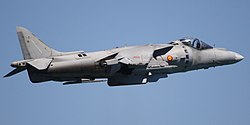P.1127 / prototype / evaluation aircraft operators
 United Kingdom
United Kingdom- Aeroplane and Armament Experimental Establishment P.1127 and Kestrel trials and evaluation
- Royal Air Force
- Central Fighter Establishment – Kestrel (P.1127) Evaluation Squadron (also known as the Tripartite Evaluation Squadron), nine Kestrel aircraft allocated for evaluation in 1965. One aircraft was lost in an accident, six aircraft later passed to the United States Army, one to the RAE and one to Hawker-Siddeley for further trials. [1]
- Royal Aircraft Establishment P.1127 and Kestrel trials and evaluation. [1]
 United States
United States- United States Army
- (aircrew participated in both the Tri-partite Evaluation Squadron and as part of the American XV-6A Tri-service evaluation team. Had three Kestrel aircraft allocated after the evaluation at West Raynham and also acquired the three allocated to Germany. Four later transferred to the United States Air Force and two to the National Aeronautics and Space Administration). [2]
- United States Air Force
- (aircrew participated in both the Tri-partite Evaluation Squadron and as part of the American XV-6A Tri-service evaluation team but had no aircraft allocated after the evaluation at West Raynham, four former United States Army aircraft operated for trials). [2]
- United States Navy
- (aircrew participated in both the Tri-partite Evaluation Squadron and as part of the American XV-6A Tri-service evaluation team but had no aircraft allocated after the evaluation). [2]
- NASA
- operated two former United States Army Kestrels. [2]
 West Germany
West Germany - German Air Force
- (aircrew participated in the Tri-partite Evaluation Squadron, three allocated Kestrel aircraft not delivered and passed to United States Army) [2]








